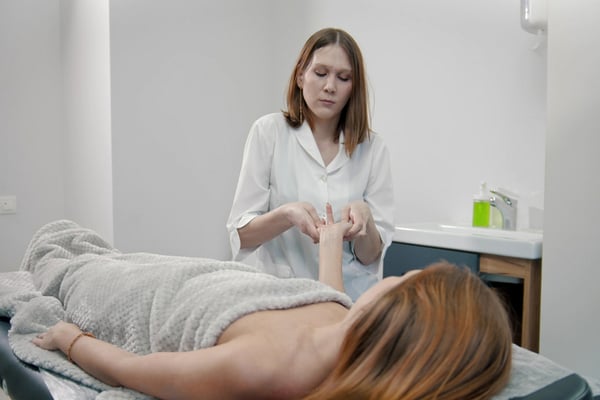What is it like working as a massage therapist? Well, it depends. Massage therapists have the option of working in widely different environments, from fitness centers to healthcare settings or even as sole practitioners.
They also have the option to practice different massage specializations. Some may work alongside physical therapists helping heal injuries and relieve muscle tension. Others provide massage therapy in more luxury settings, working to promote relaxation and relieve stress.
More recently, massage therapists have been enjoying tremendous amounts of job security. The industry has become high in demand, especially as holistic treatments become more popular. According to the Bureau of Labor Statistics (BLS), the field is slated to grow by an impressive 32 percent over the next decade.
Still, it’s not exactly an easy industry to participate in. Below, we’ll look into the challenges massage therapists face, the benefits associated with the industry, and how to avoid burning out.
[toc]How Do You Become a Massage Therapist?

All therapists require some kind of formal training before they can begin practice. Fortunately, you can earn a certificate in massage therapy in much less time than it takes to earn a traditional degree. Some massage therapy programs can be wrapped up in as little as five months, while others last upwards of two years. It all comes down to the type of massage school you plan to enroll in and how many specialties it covers.
That said, most states require a minimum of 500 hours of classroom instruction before allowing individuals to apply for their massage therapy license.
While general education courses in anatomy or medical terminology may be completed online, there is always an in-person component to massage therapy education. That standard helps secure hands-on experience in certain techniques and training that cannot be communicated remotely.
Standard courses typically include body mechanics, Swedish massage therapy, and deep tissue massage therapy. Specialty areas like medical massage therapy, hot stone and hydrotherapy techniques, and Ayurvedic massage are also offered across different massage therapy schools.
What Do Massage Therapists Find Most Difficult?
While most massage therapists report tremendous levels of job satisfaction, there are some notorious challenges associated with the field. Below, we’ll explore the most difficult parts of becoming a licensed massage therapist.
Commitment to Clinical Work
A big part of massage therapy is continuing education and clinical work. This is where students enjoy the opportunity to apply the techniques they’ve learned to a professional environment. Most states require students to complete a certain amount of clinical lab hours, though the amount will vary state to state.
Related: How long does it take to become a massage therapist?
While this shift indicates a major milestone for massage therapy students, the work can present certain challenges. For instance, hours aren’t always flexible, and they may get in the way of existing work schedules or your ability to man responsibilities at home. It also presents one final roadblock from entering the workforce.
That said, most students are able to complete their clinical lab hours without any major hiccups. Once complete, they can begin the application process and start earning money immediately.
Passing the MBLEx Exam
The Federation of State Massage Therapy Boards (FSMTB) administers the Massage and Bodywork Licensing Exam (MBLEx) year-round for prospective massage therapists. Last year, over 23,000 MBLEx exams were taken. Less than 68% of individuals passed.
The MBLEx exam is required in 45 states, as well as Puerto Rico, Washington D.C., and the U.S. Virgin Islands. The test is broken down into the following topics:
- 17% for client assessment, reassessment, and treatment plan
- 16% for ethics, regulations, laws, and boundaries
- 15% for guidelines for professional practice
- 15% for benefits and effects of techniques manipulating soft tissue
- 14% for pathology, areas of caution, contraindications, and special populations
- 12% kinesiology
- 11% anatomy and physiology
Fortunately, there are ways to secure a passing grade, and it all boils down to preparation. There are plenty of free resources available to help you study for the exam. The FSMTB also offers guides, FAQs, tips, and practice exams for you to review before the test.
Physical Demands

By now, we should be clear that massage therapists relieve pain, reduce stress, and rehabilitate injuries experienced by clients. What we don’t often talk about is the pain, stress, and injuries massage therapists may experience themselves.
One of the most difficult aspects of working as a massage therapist is the amount of time you spend on your feet. Massage therapists work anywhere from five to eight hours per shift. Though it is possible to relieve some of the pain this can cause by wearing the right socks and supportive shoes, prolonged stress can lead to osteoarthritis and other debilitating conditions.
And it doesn’t stop at the feet, either. According to a 2017 study, over half of massage therapists experience pain and stiffness in their hands. To preserve your massage therapy career, it’s important to avoid overexertion and practice self-care habits.
Legal Liabilities
As a professional massage therapist, it’s imperative to protect yourself from legal liabilities. Many massage therapists have faced lawsuits after customers were injured at the facility, on the table, or on their way out the door.
While most institutions are ensured, those policies don’t always extend to students or professors, especially when they step off the property to practice. Be sure to obtain your own insurance and demand clients express written consent before moving forward with treatment.
What are the Benefits of Becoming a Massage Therapist?
Now that we know why some practitioners may struggle when providing massage services, let’s focus on the many benefits the field has to offer! Check out the list below to learn more about why so many people are interested in becoming massage therapists.
Job Security
Holistic health practices have been growing in popularity and practice. More and more, patients are expressing interest in treating not just their physical ailments, but the mental, emotional, and spiritual components as well. Drug-free treatment plans are also helping drive that trend.
This growth is evidenced by the recent statistics released by the BLS. The organization predicts the massage therapy industry will balloon by 32% over the next decade, with over 20,000 new jobs opening up each year.
Related: Is massage therapy a good career?
Variety of Work Opportunities
According to the American Massage Therapy Association (AMTA), massage therapists usually work in two different settings. Practitioners can choose from hotels, hospitals, fitness clubs, salons, rehabilitation centers, or spas.
There is also a range when it comes to the type of massage you want to practice and the demographic you want to work with. For instance, practitioners have the option of specializing in pregnancy massage, working predominantly with expectant mothers. They can also work at nursing homes, tending to the elderly population. Other massage therapists want to focus on sports massage, rehabilitating athletes and individuals in training.
Opportunities for Growth
Massage therapists can always add certain specialties to their list of offerings, attracting new clients looking for more expensive treatments. For instance, many massage therapists have increased their earnings by offering additional luxuries, including aromatherapy, acupuncture, and hot stone therapies.
You can also further your career in massage therapy by opening up your own business. As a self-employed practitioner, you’ll be able to set your own hours, rates, and even practice from the comfort of home.
How Massage Therapists Can Avoid Burning Out

Though incredibly rewarding, a career in massage therapy comes with some unique demands. Check out the tips below to learn how professionals can stay productive on the job.
Change Your Work Environment
Many massage therapists will experience the desire to change their work environment. Whether it’s the kind of clientele your facility caters to, the distance from home, or the people you work with, there are many legitimate reasons to change jobs.
Fortunately for massage therapists, there are plenty of opportunities around, and they exist in a wide variety of settings. Whether you’re looking for a more medical path or a career in luxury services, there are plenty of positions to choose from.
Working as an independent contractor is another option that appeals to most massage therapists. If you’re thinking about taking this route, be sure to enroll in a school that emphasizes professional development in its curriculum.
Change Your Specialty
It is never too late to change your specialty. Continuing education courses are affordable and easy to access. They also don’t require too much time, meaning you can begin studying a new field while continuing to practice.
Change Your Schedule
People have many different needs when it comes to their work schedules. While some full-time practitioners may want to work the traditional nine-to-five, others prefer to engage in part-time work during nights or weekends. That way, they’re free to pursue other opportunities during typical work hours.
The good news is that massage therapy clinics, spas, and centers offer all types of hours. Self-employed practitioners have even more control over their schedules, working as much – or as little- as they like.
Change Your Rate
Certain sources suggest that massage therapists generally undercharge for their services. This finding isn’t entirely surprising, given that the industry remains predominantly female at 86%. And, as per recent analysis, women continue to earn just 84% of what men make.
With that, it’s safe to assume that many practitioners are entitled to more money for their services. If you don’t have the luxury of setting your own rate, you can look into the highest-paying fields the industry has to offer.
The AMTA reports that individuals working in hotels, resorts, or on cruise ships make more than those working in chains, salons, and clinics.
Related: How much money can I make as a massage therapist?
FAQs
Is it hard to make money as a massage therapist?
The median salary for massage therapists in 2020 was $43,620. Though it’s a fairly average salary, therapists who are able to leave school and start their own practice can exponentially increase their earnings potential. Individuals who work in hotels, resorts, or on cruise ships can also earn high hourly rates.
Is it worth becoming a massage therapist?
The answer depends on what you are looking for in your career. Massage therapists tend to work long days for a modest amount of money, especially early in their careers. The job also puts you on your feet for many hours at a time. That said, massage therapy does provide opportunities to create your own schedule and help others live more fulfilling lives. Massage therapists systematically report extremely high levels of job satisfaction.
How long does it take to learn massage therapy?
The average massage therapy program requires at least 500 hours of study, though some programs run for 1,000 or more hours. It should be noted, however, that massage therapy requires a continued commitment to lifelong learning and education.
What are the challenges of being a massage therapist?
While it remains an extremely rewarding occupation, massage therapy does present a unique set of challenges. The job can create a lot of wear and tear on the body, with practitioners working on their feet for long hours at a time. Conditions such as carpal tunnel and arthritis can lead to an inability to practice. Legal liability can also introduce additional challenges.
Are there benefits to massage therapy for cancer patients?
Studies have shown that massage therapy can be beneficial for cancer patients. Massage therapy can provide relief from cancer symptoms and treatment. What’s more, patients are expressing increasing interest in enhancing conventional treatments with complementary therapies, including massage.
What are some of the services massage therapists provide to their clients?
Massage therapists typically do the following:
Discuss symptoms, medical history, and desired results with clients
Evaluate clients to locate problem areas of the body
Manipulate muscles or other soft tissues of the body
Provide guidance on how to decrease pain, improve posture, and enhance relaxation
How long does the typical massage last?
A massage can be completed in as little as fifteen minutes or go for longer than an hour. Therapists may also provide additional treatments and instruct clients on specific massage techniques to practice between sessions.
Conclusion
The massage therapy field is booming, with more than 23,300 job openings expected to hit the market each year over the next decade.
Start your journey towards a successful career at ICOHS College. Our Professional Massage Therapist certificate program is a California Massage Therapy Council (CAMTC) approved school as recognized by the state of California. Program courses include the following subjects:
- Fundamentals of Massage
- Kinesiology and Client Assessment
- Anatomy and Deep Tissue
- Eastern Modalities
- Western Modalities
- Body Systems, Pathology, and Special Populations
- Career Development
Students will receive bodywork techniques and therapeutic massage methods designed to relieve pain and improve the overall health and wellness of their clients. They’ll also undergo classroom experiences to learn all necessary medical terminology and prepare for the state licensing exam. Financial aid options apply to those who qualify.
After leaving our programs, students can find promising career opportunities at massage therapy clinics, spas and resorts, cruise ships, holistic health centers, and more. Students may also open up their own businesses or work as independent contractors.










